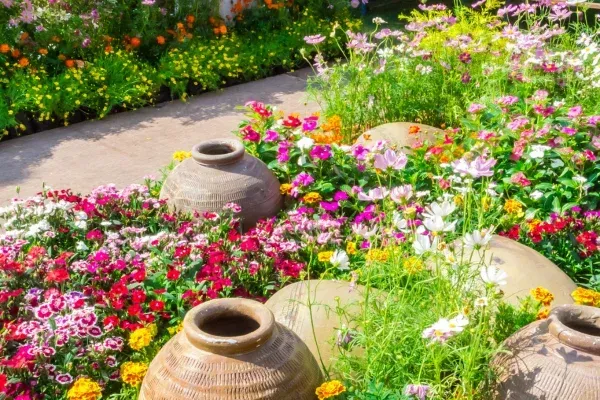
Why Soft Landscaping is the Key to a Beautiful Ingatestone Garden | Expert Guide
If you’re a homeowner in Ingatestone, chances are your garden means more to you than just a patch of grass. It’s a place where you relax after work, entertain friends in the summer, or watch your kids run around. But here’s the thing—having a truly beautiful garden isn’t just about neat paving or a new fence. The real magic lies in soft landscaping, and it’s often the difference between a yard that feels flat and one that feels alive.
In a village like Ingatestone, where greenery blends seamlessly with charming historic homes and rolling Essex countryside, soft landscaping isn’t just a luxury—it’s almost a necessity. It brings out the natural beauty of the area, complements the local climate, and makes your property stand out in a way that hard landscaping alone never could.
In this post, we’ll dive deep into what soft landscaping is, why it matters so much for Ingatestone gardens, and how you can use it to transform your outdoor space.

What Exactly Is Soft Landscaping?
Soft landscaping is all about the living elements of your garden—the plants, shrubs, flowers, turf, hedges, and trees. It’s what gives your garden life, colour, and texture. While hard landscaping (things like patios, pathways, and decking) sets the structure, soft landscaping fills in the heart and soul of the space.
Think of it this way: if your garden were a home, the hard landscaping would be the walls and floors, while the soft landscaping would be the furniture, artwork, and little touches that make it feel warm and inviting.
Why Soft Landscaping Matters So Much in Ingatestone
You might be wondering—why is soft landscaping such a big deal for Ingatestone specifically? Let’s break it down:
1. The Local Climate Works in Your Favour
Ingatestone sits in Essex, where the climate is generally mild with a mix of sun and rain that helps plants thrive. That means you can get creative with planting choices, from vibrant seasonal flowers to year-round greenery. A little planning goes a long way, and with the right mix, you can keep your garden looking stunning in every season.
2. It Complements the Historic Charm of the Village
Ingatestone is known for its Tudor-style buildings, leafy lanes, and countryside feel. A carefully planned soft landscaping design doesn’t just make your garden pretty—it helps your property blend beautifully with its surroundings. Whether you own a period home or a newer build, soft landscaping can tie your outdoor space into the wider character of the area.
3. It Increases Property Value
Buyers in Ingatestone often look for homes with attractive, well-kept gardens. Soft landscaping gives that “wow factor” at first glance. A lawn framed with neat borders, colourful perennials, and soft hedging makes a home instantly more appealing.
4. It Creates a Space You Actually Use
A hard-paved yard can look stark and uninviting, but add greenery, and suddenly it feels like a place you want to spend time. Soft landscaping makes your garden not just beautiful, but also livable—perfect for BBQs, quiet evenings, or weekend gardening.
Elements of Soft Landscaping That Work Best in Ingatestone
When it comes to designing your garden, not all plants or styles are equal. Here are some key elements to consider:
Lawns
A healthy, well-maintained lawn is often the centrepiece of a garden. In Ingatestone, lawns grow well thanks to the rainfall, but they do need proper care. Aerating, fertilising, and reseeding when needed keeps grass lush and green.
Borders and Beds
Borders give you the chance to add layers of colour and texture. Mixing perennials with shrubs means you get year-round interest. Lavender, roses, and hydrangeas all do well in Essex soil and climate.
Trees and Shrubs
Trees add structure and shade. Consider native species like oak or birch if you want something long-lasting. Shrubs such as boxwood or holly provide evergreen structure that looks good even in the winter.
Seasonal Planting
Soft landscaping shines when it changes with the seasons. Spring bulbs, summer blooms, autumn foliage, and winter greenery keep your garden lively year-round.
Hedging for Privacy
Many Ingatestone gardens are overlooked, and hedging is a softer, more attractive alternative to fencing. Yew, beech, or laurel hedges give privacy and reduce noise, all while looking natural.
Benefits of Investing in Soft Landscaping
Still not convinced? Here’s why soft landscaping is one of the best investments you can make for your garden:
Boosts kerb appeal – Your front garden is the first thing people see.
Encourages biodiversity – Plants attract bees, butterflies, and birds, making your garden part of the local ecosystem.
Improves air quality – More greenery means cleaner, fresher air.
Adds personality – Your choice of plants reflects your taste and lifestyle.
Increases relaxation – Studies show that green spaces help reduce stress.
The Best Manufacturers for Soft Landscaping Products
To make soft landscaping projects easier, many homeowners rely on quality products such as turf, soil, and fertilisers. Choosing the right manufacturers ensures long-lasting results.
Here are some of the best-known names in the industry:
Rolawn – Known for premium-quality turf and lawn care products.
Scotts – Offers reliable fertilisers and plant care solutions.
John Innes – Famous for high-quality composts ideal for a variety of planting needs.
Miracle-Gro – Widely trusted for easy-to-use plant food and soil enhancers.
Evergreen – Great for all-round garden feeds and treatments.
Each of these manufacturers provides reliable products that make maintaining a beautiful garden simpler and more effective.
Why Work with Our Team
Our team has been transforming gardens with professional soft landscaping for years. We know what works in Ingatestone, from soil conditions to plant choices. As with anything in life, you want to work with the best to get the best results—and in the long run, that choice saves you money, time, and frustration.
If you’re ready to get your project started by our team of industry experts, call us today at +44 785 280 8890 and let’s bring your dream garden to life.
Frequently Asked Questions About Soft Landscaping in Ingatestone
What’s the difference between hard landscaping and soft landscaping?
Hard landscaping refers to the non-living features in your outdoor space — things like patios, driveways, retaining walls, decking, and other man-made elements that give your garden design its structure. These hard landscaping elements form the “bones” of your garden and often have an immediate impact on how the space is used.
Soft landscaping refers to the living elements such as plants, trees, shrubs, grass, flower beds, and climbing plants. These soft elements bring life, colour, texture, and seasonal interest to your garden. While hard landscaping focuses on creating a solid base, soft landscaping focuses on the growth and beauty that happens around those structural elements.
How do hard and soft elements work together?
The best garden landscaping projects use a mix of hard and soft elements. The hard surfaces like patios and decking define how you use your outdoor area, while the soft landscaping features — like flower beds, trees, and low maintenance plants — bring in natural beauty and visual appeal.
When planned well, hard landscaping features such as retaining walls can help with proper drainage and soil erosion control, while soft landscaping elements improve air quality, support local wildlife, and even help reduce stress. Together, they create a balanced, beautiful landscape design.
Why should I invest in soft landscaping?
Soft landscaping is about more than just looks. It helps improve air quality by absorbing carbon dioxide, encourages local wildlife, and can even reduce stress by connecting you with natural elements. Soft landscape materials also help regulate temperature, reduce noise, and manage water naturally.
From flower beds and shrubs to climbing plants and trees, these growing elements add visual interest and seasonal interest year-round. Plus, soft materials are often more cost effective and can be changed more easily than hard landscaping if your garden needs evolve over time.
What are some examples of hard landscaping features?
Hard landscaping refers to any permanent structural elements that shape and support your outdoor space. Examples include:
Patios and decking for outdoor seating
Driveways for practical access
Retaining walls to manage soil conditions and prevent soil erosion
Raised flower beds for creative planting
Other features like steps, paths, and water features
These hard landscaping projects are key to building a strong foundation for your garden transformation.
How do I choose the right plants and soft landscaping features?
Choosing the right soft landscaping elements depends on your soil conditions, climate, and how much ongoing maintenance you’re willing to do. If you want something low maintenance, consider low maintenance plants like evergreen shrubs or grass varieties that require minimal care.
Think about seasonal interest too — mixing plants with different flowering times, varying heights, and texture will keep your garden looking great all year. Climbing plants and trees can add visual interest and provide shade, while flower beds and soft materials like mulch can enhance colour and contrast.
Can soft landscaping help save money in the long run?
Yes, it can. Well-chosen soft elements can be very cost effective. Low maintenance plants reduce water and care costs, while soft landscaping features that attract local wildlife can help with natural pest control. Proper drainage created by soft materials like mulch and soil also prevents costly water damage.
Plus, a healthy garden with growing elements improves the environment around your home and can even increase property value, making it a smart long-term investment.
How much maintenance do hard and soft landscaping need?
Hard landscaping features like patios, driveways, and retaining walls need very little ongoing maintenance once installed. Occasionally, you may need to clean or repair them, but they’re designed to last for years.
Soft landscaping, on the other hand, involves living elements that need regular care — watering, pruning, weeding, and seasonal adjustments. However, with careful planning and horticultural knowledge, you can choose low maintenance plants and soft materials that make looking after your green spaces much less time consuming.
Do I need a professional for my garden design?
While some garden design tips and simple planting can be done yourself, professional help is often worth it — especially for larger hard landscaping projects or if you’re unsure about soil conditions, drainage, or plant selection. Professionals have the horticultural knowledge to combine hard and soft landscaping in a way that suits your garden needs, lifestyle, and budget.
They can also help with careful planning so your outdoor space grows beautifully over time and requires less ongoing maintenance.
✅ Conclusion – Soft Landscaping and Hard Landscaping Work Best Together
In conclusion, soft landscaping and hard landscaping are most powerful when they’re combined thoughtfully. Hard landscaping builds the foundation and structure, while soft landscaping brings your garden to life with colour, texture, and natural elements. With the right balance, you’ll create a welcoming, functional, and sustainable outdoor space that looks great year round.

Final Thoughts
Soft landscaping isn’t just about adding a few plants. It’s about designing a space that reflects your lifestyle, enhances your home, and makes the most of Ingatestone’s natural beauty. Whether you want a family-friendly lawn, a colourful flower-filled border, or a private green retreat, soft landscaping is the key to achieving it.
If you’re ready to bring your garden to life, don’t wait. Contact us today at +44 785 280 8890 and let’s Kaizen Si start planning your perfect Ingatestone garden together.
